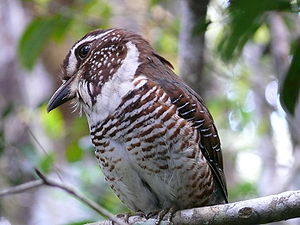Bandage cloth
| Bandage cloth | ||||||||||
|---|---|---|---|---|---|---|---|---|---|---|

Sorrel ( Brachypteracias leptosomus ) |
||||||||||
| Systematics | ||||||||||
|
||||||||||
| Scientific name | ||||||||||
| Brachypteracias leptosomus | ||||||||||
| ( Lesson , 1833) |
The Bindenerdracke ( Brachypteracias leptosomus ) [Bind earth Racke] is an endemic in Madagascar occurring bird from the family of the ground roller (Brachypteraciidae).
features
Binder pads reach a body length of 30 to 38 centimeters. The weight of a male was measured to be 186 grams and that of a female was 154 grams. The top of the head is maroon, the back is olive brown. The throat, chest, flanks and stomach are brownish with whitish stripes and speckles. A stripe over the eyes and a wide band below the throat stand out clearly in white. The tips of the arm and hand wings are also white. There is practically no sexual dimorphism between the sexes . The females show similar drawing patterns as the males, but are slightly smaller. The strong beak is black in both sexes, the iris dark brown. The relatively short legs are pale yellow-gray in color.
voice
The male's territorial call consists initially of a repeated deep 'buub' sounding tone, which is followed by a 'dududududu…' series of tones in rapid succession after a short pause. It is presented from a height of between 5 and 30 meters before sunrise.
distribution and habitat
The distribution area of the Bindenerdracke covers an area of approx. 39,200 km² almost on the entire east side of Madagascar. It prefers to colonize dense, shady forests up to an altitude of 1500 meters.
Way of life

The birds feed primarily on various invertebrates such as ants , beetles , cicadas , caterpillars , millipedes , grasshoppers , lobsters , nudibranchs and worms . Sometimes small vertebrates are also preyed on, such as chameleons , geckos , lizards , snakes and frogs . The prey animals are killed by hitting a branch or swallowed whole. The birds usually stay in trees and bushes, only occasionally on the ground. The breeding season falls from October to January. The couples live monogamous . Little is known about nest building. Individual nest holes were found in tree hollows and on the ground under roots. The nest is filled with one or two eggs, which the female hatches in 22 to 24 days. It is supplied with food by the male on the nest. After hatching, the young are fed by both parents and fly out after about 30 days.
Danger
The trampoline is common in the national parks in eastern Madagascar and the adjacent areas. As a result of the reclamation of some of its habitats, however, it is in a slight decline and is therefore classified by the IUCN as " vulnerable ".
literature
- Josep del Hoyo , Andrew Elliott, Jordi Sargatal : Handbook of the Birds of the World, Mousebirds to Hornbills. Volume 6, Lynx Edicions, 2001, ISBN 978-84-87334-30-6 .
Web links
- worldbirdnames - IOC World Bird List
- Bindweed (Brachypteracias leptosomus) in the Encyclopedia of Life . Retrieved August 11, 2017.
Individual evidence
- ↑ a b c d e O. Langrand & GM Kirwan (2017). Short-legged ground-roller (Brachypteracias leptosomus). In: J. del Hoyo, A. Elliott, J. Sargatal, DA Christie & E. de Juana (eds.). Handbook of the Birds of the World Alive. Lynx Edicions, Barcelona. (accessed at http://www.hbw.com/node/55865 on March 18, 2017).
- ↑ occurrence
- ^ IUCN Red List